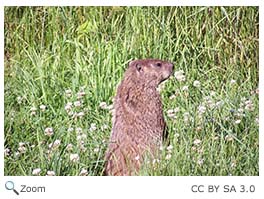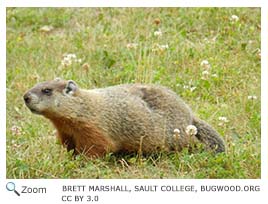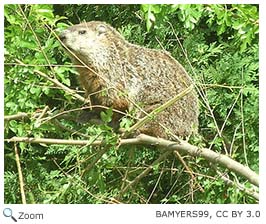Woodchuck -Marmota monax |
||||||||
Description The woodchuck has a body built for burrowing with short powerful legs, sharp curved claws, a rounded head and and fur-covered ears designed to keep out dirt. They have long sharp front teeth that will grow too long if they don't they wear them down by chewing on things. Range HabitatThe woodchuck is found in a variety of habitats including fields, forests, hedgerows, and pastures. Woodchucks are burrowing animals and make both summer and winter burrows. Their summer burrows are usually close to a food source. Their winter burrow is made in a place where they can hibernate. Woodchuck burrows usually have more than one entrance and multiple chambers, including one they use as a bathroom. Burrows can be anywhere from 6-80 feet in length and can have more than one level. Woodchucks use their burrows for sleeping, protection, as a place to raise their pups, and for hibernation. Woodchucks are true hibernators. They hibernate from the late winter to the early spring. During hibernation, both their heart rate and body temperature drop dramitically. Their body temperature can drop from from 99 °F to 40 °F and their heart rate can drop from 100 beats per minute to a few as 4 beats per minute. While they are dormant during long periods of hibernation, they do wake up for 2-3 day periods during hibernation. | Diet When the woodchuck is eating, it often looks up to check for predators. Its burrow is usually very close to where it feeds, so it can scurry back to safety if it spots a predator. When it is outside but not feeding, it will stand on its hinds legs and keep a lookout for predators. Life Cycle Behavior
Woodchucks usually retreat to their burrows when they are threatened, but they also climb trees to avoid predators. |
|||||||

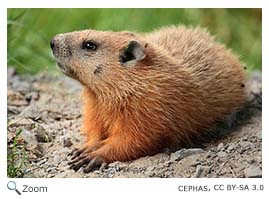
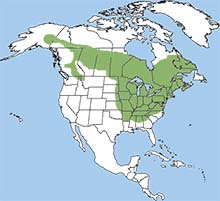 The woodchuck is found across much of the eastern U.S. and across much of southern Canada. It is also
found in Alaska.
The woodchuck is found across much of the eastern U.S. and across much of southern Canada. It is also
found in Alaska.